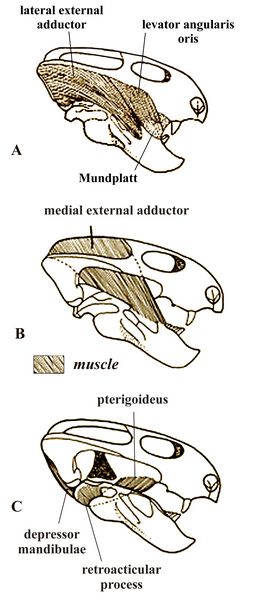Athena Review Image Archive ™
Pristerodon chewing muscles

Chewing muscles of Pristerodon (after Benton 2005).
Pristerodon were
small plant-eating dicynodonts ("two dog teeth") from the Late Permian period, found
in South Africa. First described by Huxley in 1868 as the species P. mackayi, they are included in the clade Therapsida, the infraorder Dicynodontia, and the family Eumantellidae.
Like most dicynodonts, Pristerodon
were herbivores who lived on river floodplains. Pristerodon, Their
skull was 4-6 cm long, with a short snout. Unlike most other
dicynodonts, however, Pristerodon
had six pointed post-canine teeth on either side of its upper and lower
jaws (maxilla and dentary). The rest of the jaws were made of
sharp bone, probably covered with keratin or a horny surface (Benton
2005). Pristerodon lived on
vegetation which it snipped off with its horny beak, then passed back
to its cheek area for grinding with its molars before swallowing.
Pristerodon's jaw was built as a flexible unit, able to slide back and forth while eating. The key chewing muscles included a 1) large lateral external adductor that contracted the jaw, running from the back of the skull (squamosal and quadratojugal bones) to a long ridge on the side of the dentary; 2) another jaw contractor, the medial external adductor that ran inside the zygomatic arch from the parietal bone at the top of the skull, to the top of the dentary; 3) a small pterygoidus muscle that pulled the jaw forward; and 4) the depressor mandibulae, which opened the jaw. This ran from the back of the skull (squamosal bone) to the retroarticular process, the part of the jaw behind the jaw joint (Benton 2005).
Recently, Pristerodon have also been identified as among the earliest land animals able to hear airborne sound, as opposed to hearing via ground vibrations. A South African specimen has shown evidence of an eardrum on its lower jaw (Laass 2015). It had a 3 mm cavity for the cochlea or eardrum, which transformed sound frequencies into nerve impulses sent to the brain.
The
importance of the evolution of hearing has increased focus in the development of the lower
jaw and related muscles of Pristerodon. There is an implication that, during the act of chewing, its hearing was impaired.
References
Benton 2005 Vertebrate Paleontology.
Laass, M. 2015. The origins of the cochlea and impedance matching hearing in synapsids. Acta Palaeontologica Polonica. 60.
Copyright © 1996-2020 Rust Family Foundation (All Rights Reserved).